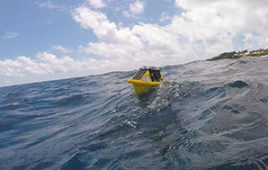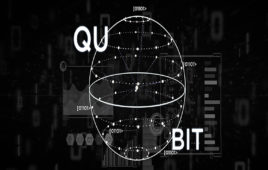 Researchers studying how the brain makes decisions have, for the first time, recorded the moment-by-moment fluctuations in brain signals that occur when a monkey making free choices has a change of mind.
Researchers studying how the brain makes decisions have, for the first time, recorded the moment-by-moment fluctuations in brain signals that occur when a monkey making free choices has a change of mind.
The findings result from experiments led by electrical engineering Professor Krishna Shenoy, whose Stanford lab focuses on movement control and neural prostheses — such as artificial arms — controlled by the user’s brain.
“This basic neuroscience discovery will help create neural prostheses that can withhold moving a prosthetic arm until the user is certain of their decision, thereby averting premature or inopportune movements,” Shenoy said.
The experiments are described in the journal eLife. They were performed by neuroscientist Matthew Kaufman while he was a graduate student in Shenoy’s lab.
Kaufman taught laboratory monkeys to perform a decision-making task. He then developed a technique to track the brain signals that occur during a single decision with split-second accuracy. This improvement on what’s called the “single trial decoder” algorithm revealed the neural signals that occurred during a momentary hesitation or when the monkey changed his mind.
“We are seeing many cognitive phenomena in the brain for the first time,” said Kaufman, who is now a postdoctoral scholar at Cold Spring Harbor Laboratory. “The most critical result of our work here is that we can track a single decision and see how the monkey arrived there: whether he decided quickly, slowly, or changed his mind halfway through.”
The experiments
The experiments involved monkeys that were trained to reach for either of two targets on a computer screen. It was often possible to reach either target, inviting a free choice. Sometimes, one target was blocked, resulting in a forced choice. Other times, the researchers would switch between these configurations while the monkey was deciding, encouraging a change of mind.
The research focused on the time the monkey spent deliberating, before the actual movement began. The monkeys were trained to sit motionless while two jittering targets were positioned on either side of a computer screen.
Colored barriers on the screen created a simple maze. When the targets stopped jittering the monkeys were trained to move to one or the other target by sweeping his fingertip through the maze until he touched one of the targets.
During the experiments, 192 electrodes in each monkey’s motor and premotor cortex began measuring brain activity the moment that the targets appeared on screen. The measurements continued until the targets stopped jittering and the monkey began to move. The interval between the targets’ appearance and the beginning of movement marked the time of decision or, in some cases, hesitation.
The single-trial advantage
Using his single-trial decoder algorithm, Kaufman could analyze moment-by-moment brain activity during each individual decision. In a sense, he was able to read the monkey’s mind during free choices, when each decision may be different.
In previous experiments on decision-making, researchers have had monkeys perform many trials and average the readings they obtain to get summary statistics. But these older approaches do not allow researchers to identify unique or idiosyncratic events during any individual decision.
“We can now track single decisions with unprecedented precision,” Kaufman said. “We saw that the brain activity for a typical free choice looked just like it did for a forced choice. But a few of the free choices were different. Occasionally, he was indecisive for a moment before he made any plan at all. About one time in eight, he made a plan quickly but spontaneously changed his mind a moment later.”
This deeper understanding of decision-making will help researchers to fine-tune the control algorithms of neural prostheses to enable people with paralysis to drive a brain-controlled prosthetic arm or guide a neurally-activated cursor on a computer screen.
Two former Stanford postdocs also contributed to this paper: Mark M. Churchland, now an assistant professor at Columbia University, and Stephen I. Ryu, now a consulting professor of electrical engineering at Stanford and a neurosurgeon at the Palo Alto Medical Foundation.
The philosophical implications
Kaufman said the team’s findings also bear on a longstanding philosophical debate about human consciousness.
In the early 1980s, University of California, San Francisco neuroscientist Benjamin Libet conducted an experiment to assess the nature of free will. Subjects hooked up to an electroencephalogram (EEG) were asked to push a button whenever they liked. They were also asked to note the precise time that they first became aware of the wish or urge to move.
Libet’s experiments showed that distinctive brain activity began, on average, several seconds before subjects became aware that they planned to move. Libet concluded that the desire to move arose unconsciously, and “free will” could only come in the form of a conscious veto: what he called “free won’t.”
Kaufman said that the brain activity Libet saw does not imply a demise of free will. Instead, his results show that you can plan to make a particular movement, but sometimes change your mind a second later. The moment of commitment to your choice might therefore happen late, just as Libet’s subjects reported. “Being able to see how each choice unfolds on a millisecond timescale may help make it possible to better study these kinds of slippery issues,” Kaufman said.
This work was supported in part by a Director’s Pioneer Award from the National Institutes of Health and by a REPAIR grant from the Defense Advanced Research Projects Agency.




